Kai-Fu Yang
Visual Attention Graph
Mar 11, 2025Abstract:Visual attention plays a critical role when our visual system executes active visual tasks by interacting with the physical scene. However, how to encode the visual object relationship in the psychological world of our brain deserves to be explored. In the field of computer vision, predicting visual fixations or scanpaths is a usual way to explore the visual attention and behaviors of human observers when viewing a scene. Most existing methods encode visual attention using individual fixations or scanpaths based on the raw gaze shift data collected from human observers. This may not capture the common attention pattern well, because without considering the semantic information of the viewed scene, raw gaze shift data alone contain high inter- and intra-observer variability. To address this issue, we propose a new attention representation, called Attention Graph, to simultaneously code the visual saliency and scanpath in a graph-based representation and better reveal the common attention behavior of human observers. In the attention graph, the semantic-based scanpath is defined by the path on the graph, while saliency of objects can be obtained by computing fixation density on each node. Systemic experiments demonstrate that the proposed attention graph combined with our new evaluation metrics provides a better benchmark for evaluating attention prediction methods. Meanwhile, extra experiments demonstrate the promising potentials of the proposed attention graph in assessing human cognitive states, such as autism spectrum disorder screening and age classification.
PESFormer: Boosting Macro- and Micro-expression Spotting with Direct Timestamp Encoding
Oct 24, 2024



Abstract:The task of macro- and micro-expression spotting aims to precisely localize and categorize temporal expression instances within untrimmed videos. Given the sparse distribution and varying durations of expressions, existing anchor-based methods often represent instances by encoding their deviations from predefined anchors. Additionally, these methods typically slice the untrimmed videos into fixed-length sliding windows. However, anchor-based encoding often fails to capture all training intervals, and slicing the original video as sliding windows can result in valuable training intervals being discarded. To overcome these limitations, we introduce PESFormer, a simple yet effective model based on the vision transformer architecture to achieve point-to-interval expression spotting. PESFormer employs a direct timestamp encoding (DTE) approach to replace anchors, enabling binary classification of each timestamp instead of optimizing entire ground truths. Thus, all training intervals are retained in the form of discrete timestamps. To maximize the utilization of training intervals, we enhance the preprocessing process by replacing the short videos produced through the sliding window method.Instead, we implement a strategy that involves zero-padding the untrimmed training videos to create uniform, longer videos of a predetermined duration. This operation efficiently preserves the original training intervals and eliminates video slice enhancement.Extensive qualitative and quantitative evaluations on three datasets -- CAS(ME)^2, CAS(ME)^3 and SAMM-LV -- demonstrate that our PESFormer outperforms existing techniques, achieving the best performance.
Weak Supervision with Arbitrary Single Frame for Micro- and Macro-expression Spotting
Mar 21, 2024



Abstract:Frame-level micro- and macro-expression spotting methods require time-consuming frame-by-frame observation during annotation. Meanwhile, video-level spotting lacks sufficient information about the location and number of expressions during training, resulting in significantly inferior performance compared with fully-supervised spotting. To bridge this gap, we propose a point-level weakly-supervised expression spotting (PWES) framework, where each expression requires to be annotated with only one random frame (i.e., a point). To mitigate the issue of sparse label distribution, the prevailing solution is pseudo-label mining, which, however, introduces new problems: localizing contextual background snippets results in inaccurate boundaries and discarding foreground snippets leads to fragmentary predictions. Therefore, we design the strategies of multi-refined pseudo label generation (MPLG) and distribution-guided feature contrastive learning (DFCL) to address these problems. Specifically, MPLG generates more reliable pseudo labels by merging class-specific probabilities, attention scores, fused features, and point-level labels. DFCL is utilized to enhance feature similarity for the same categories and feature variability for different categories while capturing global representations across the entire datasets. Extensive experiments on the CAS(ME)^2, CAS(ME)^3, and SAMM-LV datasets demonstrate PWES achieves promising performance comparable to that of recent fully-supervised methods.
Nighttime Thermal Infrared Image Colorization with Feedback-based Object Appearance Learning
Oct 24, 2023Abstract:Stable imaging in adverse environments (e.g., total darkness) makes thermal infrared (TIR) cameras a prevalent option for night scene perception. However, the low contrast and lack of chromaticity of TIR images are detrimental to human interpretation and subsequent deployment of RGB-based vision algorithms. Therefore, it makes sense to colorize the nighttime TIR images by translating them into the corresponding daytime color images (NTIR2DC). Despite the impressive progress made in the NTIR2DC task, how to improve the translation performance of small object classes is under-explored. To address this problem, we propose a generative adversarial network incorporating feedback-based object appearance learning (FoalGAN). Specifically, an occlusion-aware mixup module and corresponding appearance consistency loss are proposed to reduce the context dependence of object translation. As a representative example of small objects in nighttime street scenes, we illustrate how to enhance the realism of traffic light by designing a traffic light appearance loss. To further improve the appearance learning of small objects, we devise a dual feedback learning strategy to selectively adjust the learning frequency of different samples. In addition, we provide pixel-level annotation for a subset of the Brno dataset, which can facilitate the research of NTIR image understanding under multiple weather conditions. Extensive experiments illustrate that the proposed FoalGAN is not only effective for appearance learning of small objects, but also outperforms other image translation methods in terms of semantic preservation and edge consistency for the NTIR2DC task.
Weakly-supervised Micro- and Macro-expression Spotting Based on Multi-level Consistency
May 04, 2023



Abstract:Most micro- and macro-expression spotting methods in untrimmed videos suffer from the burden of video-wise collection and frame-wise annotation. Weakly-supervised expression spotting (WES) based on video-level labels can potentially mitigate the complexity of frame-level annotation while achieving fine-grained frame-level spotting. However, we argue that existing weakly-supervised methods are based on multiple instance learning (MIL) involving inter-modality, inter-sample, and inter-task gaps. The inter-sample gap is primarily from the sample distribution and duration. Therefore, we propose a novel and simple WES framework, MC-WES, using multi-consistency collaborative mechanisms that include modal-level saliency, video-level distribution, label-level duration and segment-level feature consistency strategies to implement fine frame-level spotting with only video-level labels to alleviate the above gaps and merge prior knowledge. The modal-level saliency consistency strategy focuses on capturing key correlations between raw images and optical flow. The video-level distribution consistency strategy utilizes the difference of sparsity in temporal distribution. The label-level duration consistency strategy exploits the difference in the duration of facial muscles. The segment-level feature consistency strategy emphasizes that features under the same labels maintain similarity. Experimental results on two challenging datasets -- CAS(ME)$^2$ and SAMM-LV -- demonstrate that MC-WES is comparable to state-of-the-art fully-supervised methods.
Memory-Guided Collaborative Attention for Nighttime Thermal Infrared Image Colorization
Aug 05, 2022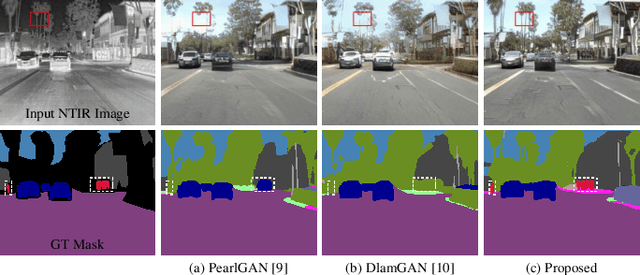

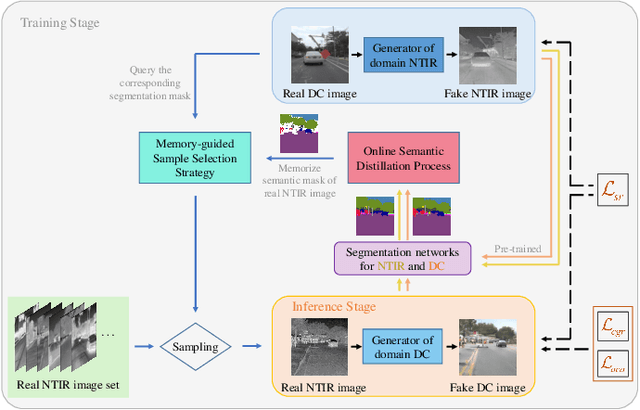
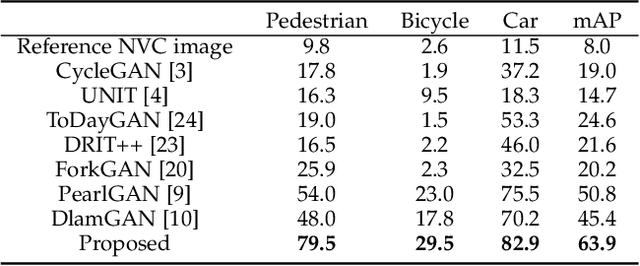
Abstract:Nighttime thermal infrared (NTIR) image colorization, also known as translation of NTIR images into daytime color images (NTIR2DC), is a promising research direction to facilitate nighttime scene perception for humans and intelligent systems under unfavorable conditions (e.g., complete darkness). However, previously developed methods have poor colorization performance for small sample classes. Moreover, reducing the high confidence noise in pseudo-labels and addressing the problem of image gradient disappearance during translation are still under-explored, and keeping edges from being distorted during translation is also challenging. To address the aforementioned issues, we propose a novel learning framework called Memory-guided cOllaboRative atteNtion Generative Adversarial Network (MornGAN), which is inspired by the analogical reasoning mechanisms of humans. Specifically, a memory-guided sample selection strategy and adaptive collaborative attention loss are devised to enhance the semantic preservation of small sample categories. In addition, we propose an online semantic distillation module to mine and refine the pseudo-labels of NTIR images. Further, conditional gradient repair loss is introduced for reducing edge distortion during translation. Extensive experiments on the NTIR2DC task show that the proposed MornGAN significantly outperforms other image-to-image translation methods in terms of semantic preservation and edge consistency, which helps improve the object detection accuracy remarkably.
Learning to Adapt to Light
Feb 16, 2022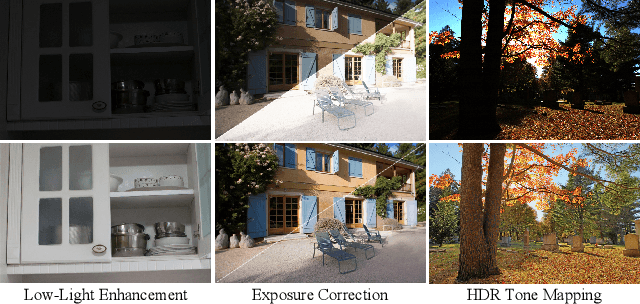
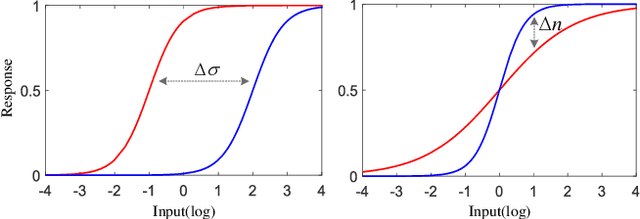
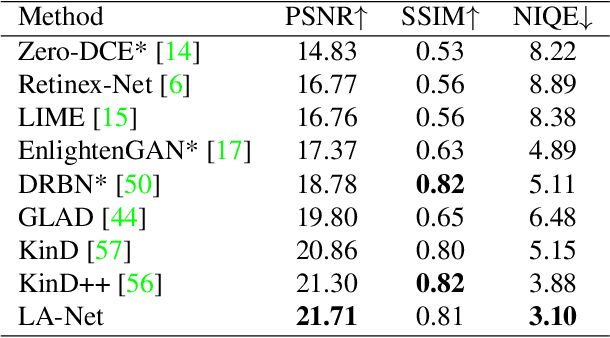
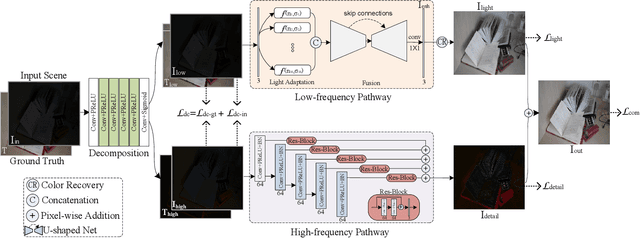
Abstract:Light adaptation or brightness correction is a key step in improving the contrast and visual appeal of an image. There are multiple light-related tasks (for example, low-light enhancement and exposure correction) and previous studies have mainly investigated these tasks individually. However, it is interesting to consider whether these light-related tasks can be executed by a unified model, especially considering that our visual system adapts to external light in such way. In this study, we propose a biologically inspired method to handle light-related image-enhancement tasks with a unified network (called LA-Net). First, a frequency-based decomposition module is designed to decouple the common and characteristic sub-problems of light-related tasks into two pathways. Then, a new module is built inspired by biological visual adaptation to achieve unified light adaptation in the low-frequency pathway. In addition, noise suppression or detail enhancement is achieved effectively in the high-frequency pathway regardless of the light levels. Extensive experiments on three tasks -- low-light enhancement, exposure correction, and tone mapping -- demonstrate that the proposed method almost obtains state-of-the-art performance compared with recent methods designed for these individual tasks.
Line Drawings of Natural Scenes Guide Visual Attention
Dec 19, 2019



Abstract:Visual search is an important strategy of the human visual system for fast scene perception. The guided search theory suggests that the global layout or other top-down sources of scenes play a crucial role in guiding object searching. In order to verify the specific roles of scene layout and regional cues in guiding visual attention, we executed a psychophysical experiment to record the human fixations on line drawings of natural scenes with an eye-tracking system in this work. We collected the human fixations of ten subjects from 498 natural images and of another ten subjects from the corresponding 996 human-marked line drawings of boundaries (two boundary maps per image) under free-viewing condition. The experimental results show that with the absence of some basic features like color and luminance, the distribution of the fixations on the line drawings has a high correlation with that on the natural images. Moreover, compared to the basic cues of regions, subjects pay more attention to the closed regions of line drawings which are usually related to the dominant objects of the scenes. Finally, we built a computational model to demonstrate that the fixation information on the line drawings can be used to significantly improve the performances of classical bottom-up models for fixation prediction in natural scenes. These results support that Gestalt features and scene layout are important cues for guiding fast visual object searching.
Salient Structure Detection by Context-Guided Visual Search
May 17, 2015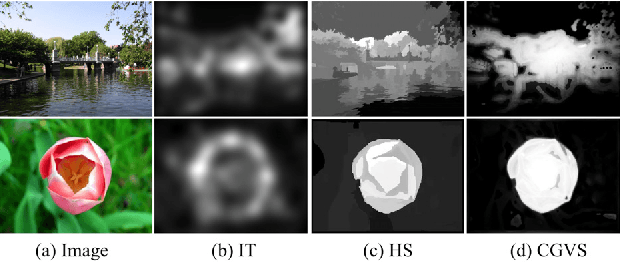
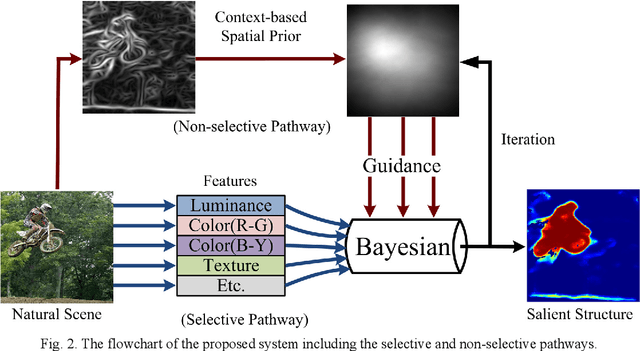
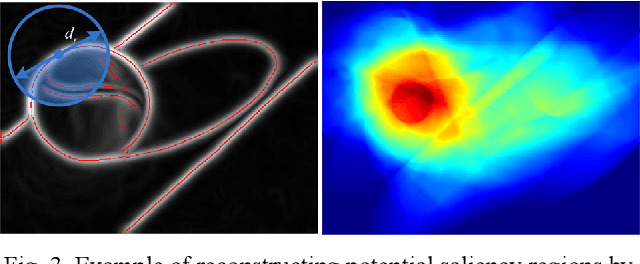
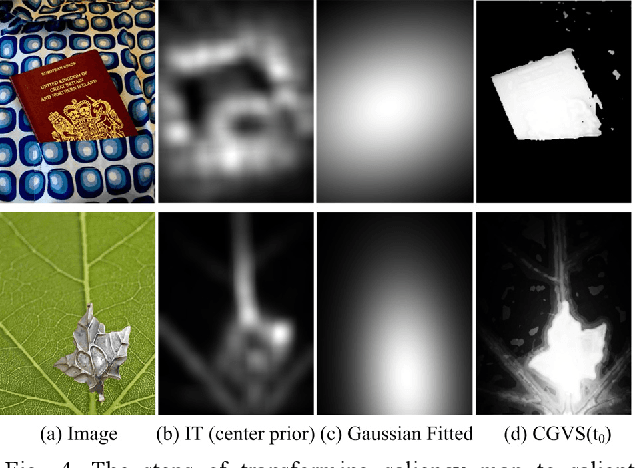
Abstract:We define the task of salient structure (SS) detection to unify the saliency-related tasks like fixation prediction, salient object detection, and other detection of structures of interest. In this study, we propose a unified framework for SS detection by modeling the two-pathway-based guided search strategy of biological vision. Firstly, context-based spatial prior (CBSP) is extracted based on the layout of edges in the given scene along a fast visual pathway, called non-selective pathway. This is a rough and non-selective estimation of the locations where the potential SSs present. Secondly, another flow of local feature extraction is executed in parallel along the selective pathway. Finally, Bayesian inference is used to integrate local cues guided by CBSP, and to predict the exact locations of SSs in the input scene. The proposed model is invariant to size and features of objects. Experimental results on four datasets (two fixation prediction datasets and two salient object datasets) demonstrate that our system achieves competitive performance for SS detection (i.e., both the tasks of fixation prediction and salient object detection) comparing to the state-of-the-art methods.
* 13 pages, 15 figures
 Add to Chrome
Add to Chrome Add to Firefox
Add to Firefox Add to Edge
Add to Edge